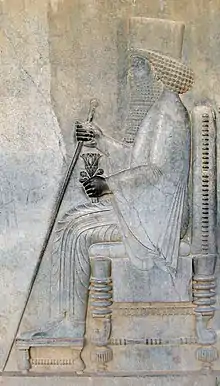Artaxerxes II
Artaxerxes II Mnemon /ˌɑːrtəˈzɜːrksiːz/ (Old Persian: 𐎠𐎼𐎫𐎧𐏁𐏂𐎠, lit. 'whose reign is through truth')[1] was the King of Kings of the Achaemenid Empire from 404 BC until his death in 358 BC. He was a son of Darius II and Parysatis.
| Artaxerxes II Mnemon 𐎠𐎼𐎫𐎧𐏁𐏂𐎠 | |||||
|---|---|---|---|---|---|
| King of Kings Great King King of Persia King of Countries | |||||
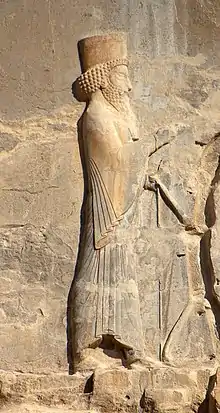 Relief of Artaxerxes II on his tomb at Persepolis, Iran. | |||||
| King of Kings of the Achaemenid Empire | |||||
| Reign | 404 to 358 BC (46 years) | ||||
| Predecessor | Darius II | ||||
| Successor | Artaxerxes III | ||||
| Born | Arsames 453 or 445 BC[1] | ||||
| Died | 358 BC (aged 86 or 94) | ||||
| Burial | 358 BC | ||||
| Consort | Stateira | ||||
| Issue | Artaxerxes III | ||||
| |||||
| House | Achaemenid | ||||
| Father | Darius II | ||||
| Mother | Parysatis | ||||
| Religion | Zoroastrianism | ||||
Greek authors gave him the epithet "Mnemon" (Ancient Greek: Μνήμων; Old Persian: abiataka), meaning "remembering"; "having a good memory."[2]
Rise to power
Darius II died in 404 BC, just before the final victory of the Egyptian general, Amyrtaeus, over the Persians in Egypt.
His successor was his eldest son Arsames, who was crowned as Artaxerxes II in Pasargadae.
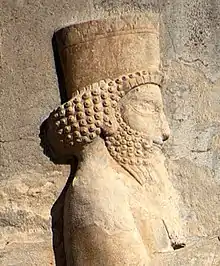
Dynastic conflict with Cyrus the Younger (401 BC)
Before Artaxerxes II could take the throne, he encountered an issue that would threaten his legitimacy as ruler of the Achaemenid Empire. Cyrus the Younger, who at the time was the appointed governor of Asia Minor, had also made claims to the throne. These claims of dethroning Artaxerxes II came to his attention from Tissaphernes, who was a satrap of Caria at the time. Tissapherenes noted that Cyrus the Younger's claims to be on a military expedition to attack the Pisidians had many flaws that led him to believe that Cyrus was planning to revolt. These claims became realized when Cyrus began to seek political support for his campaign. Cyrus found support with Sparta, who sent soldiers to aid the campaign against Artaxerxes II. Notably, Cyrus found support with a Persian kingdom of Cilicia, who contributed to the effort through funds. During this time, due to Tissaphernes' reports, Artaxerxes II began to build up a force to contend with his younger brother's revolt.[3]
By the time of Darius II's death, Cyrus had already been successful in defeating the Syrians and Cilicians and was commanding a large army made up of his initial supporters plus those who had joined him in Phrygia and beyond. Upon hearing of his father's death, Cyrus the Younger declared his claim to the throne, based on the argument that he was born to Darius and Parysatis after Darius had ascended to the throne, while Artaxerxes was born prior to Darius II's gaining the throne.
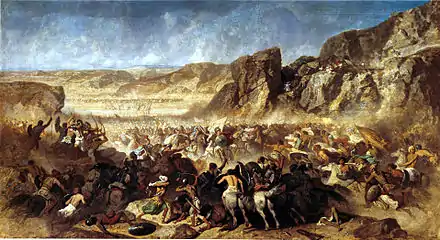
Artaxerxes II initially wanted to resolve the conflict peacefully, but the negotiations fell through.[4] Cyrus also ran into issues with the locals, who were loyal to Artaxerxes. Artaxerxes defended his position against his brother Cyrus the Younger, who with the aid of a large army of Greek mercenaries called the "Ten Thousand", attempted to usurp the throne. Though Cyrus' mixed army fought to a tactical victory at the Battle of Cunaxa in Babylon (401 BC), Cyrus himself was killed in the exchange by Mithridates, rendering his victory irrelevant. Greek historian Xenophon, himself one of the leaders of the Greek troops, would later recount this battle in the Anabasis, focusing on the struggle of the now-stranded Greek mercenaries to return home.
Reign
Conflict against Sparta (396-387 BC)

Artaxerxes became involved in a war with Persia's erstwhile allies, the Spartans, during the Corinthian War (395-387 BC). The Spartans under their king Agesilaus II had started by invading Asia Minor in 396-395 BC. To redirect the Spartans' attention to Greek affairs, Artaxerxes subsidized their enemies through his envoy Timocrates of Rhodes; in particular, the Athenians, Thebans, and Corinthians received massives subsidies. Tens of thousands of darics, the main currency in Achaemenid coinage, were used to bribe the Greek states to start a war against Sparta.[5] These subsidies helped to engage the Spartans in what would become known as the Corinthian War. According to Plutarch, Agesilaus said upon leaving Asia Minor, "I have been driven out by 10,000 Persian archers", a reference to "Archers" (Toxotai) the Greek nickname for the darics from their obverse design, because that much money had been paid to politicians in Athens and Thebes to start a war against Sparta.[6][5][7]
The Achaemenids, allied with Athens, managed to utterly destroy the Spartan fleet at the Battle of Cnidus (394 BC). After that, the Achaemenid satrap of Hellespontine Phrygia, Pharnabazus II, together with former Athenian admiral Conon, raided the coasts of Peloponnesia, putting increased pressure on the Spartans. This encouraged the resurgence of Athens, which started to bring back under her control the Greek cities of Asia Minor, thus worrying Artaxerxes II that his Athenian allies were becoming too powerful.
Final agreement with Sparta (387 BC)
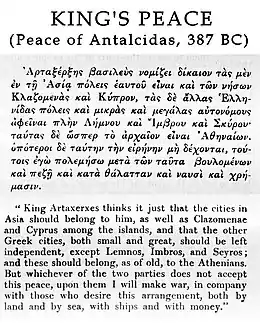
In 386 BC, Artaxerxes II betrayed his allies and came to an arrangement with Sparta, and in the Treaty of Antalcidas, he forced his erstwhile allies to come to terms. This treaty restored control of the Greek cities of Ionia and Aeolis on the Anatolian coast to the Persians, while giving Sparta dominance on the Greek mainland. In 385 BC, he campaigned against the Cadusians.
Egypt campaign (373 BC)
Although successful against the Greeks, Artaxerxes had more trouble with the Egyptians, who had successfully revolted against him at the beginning of his reign. An attempt to reconquer Egypt in 373 BC under the command of Pharnabazus, satrap of Hellespontine Phrygia, was completely unsuccessful, but in his waning years, the Persians did manage to defeat a joint Egyptian–Spartan effort to conquer Phoenicia.
Unfolding of the Egyptian campaign
In 377 BC, Pharnabazus was reassigned by Artaxerxes II to help command a military expedition into rebellious Egypt, having proven his ability against the Spartans.[8]
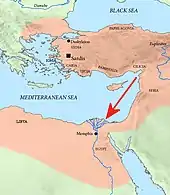
After four years of preparations in the Levant, Pharnabazus gathered an expeditionary force of 200,000 Persian troops, 300 triremes, 200 galleys, and 12,000 Greeks under Iphicrates.[9] The Achaemenid Empire had also been applying pressure on Athens to recall the Greek general Chabrias, who was in the service of the Egyptians, but in vain.[10] The Egyptian ruler Nectanebo I was thus supported by Athenian General Chabrias and his mercenaries.[11]
The Achaemenid force landed in Egypt with the Athenian general Iphicrates near Mendes in 373 BC.[12] The expedition force was too slow, giving time to the Egyptians to strengthen defenses. Pharnabazus and Iphicrates appeared before Pelusium, but retired without attacking it, Nectanebo I, king of Egypt, having added to its former defences by laying the neighboring lands under water, and blocking up the navigable channels of the Nile by embankments. (Diodorus Siculus xv. 42; Cornelius Nepos, Iphicrates c. 5.) Fortifications on the Pelusiac branch of the Nile ordered by Nectanebo forced the enemy fleet to seek another way to sail up the Nile. Eventually the fleet managed to find its way up the less-defended Mendesian branch.[10] At this point, the mutual distrust that had arisen between Iphicrates and Pharnabazus prevented the enemy from reaching Memphis. Then, the annual Nile flood and the Egyptian defenders' resolve to defend their territory turned what had initially appeared as certain defeat for Nectanebo I and his troops into a complete victory.[13]
After several weeks, the Persians and their Greek mercenaries under Iphicrates had to re-embark. The expedition against Egypt had failed.[12] It was the end of the career of Pharnabazus, who was now over 70 years old.[14] Pharnabazes was replaced by Datames to lead a second expedition to Egypt, but he failed and then started the "Satraps' Revolt" against the Great King.[14]
Revolt of the Satraps (372-362 BC)
The Achaemenid defeat in Egypt led to unrest among the Achaemenid nobility. From 372 BC, many western satrapies of the Achaemenid Empire started to rebel against Artaxerxes II, in the Great Satraps' Revolt, starting with the powerful satrap Datames. Following the failure of Pharnabazus II in Egypt, Datames had been entrusted by the Persian king with the chief command of a force designed for the recovery of Egypt, but the machinations of his enemies at the Persian court, and the risks to which he was in consequence exposed, induced him to change his plan, and throw off his allegiance to the king. He withdrew with the troops under his command into Cappadocia, and made common cause with the other satraps who were revolting from Persia.
The Pharaoh Nectanebo provided financial support to the rebelling satraps and re-established ties with both Sparta and Athens.[15] Artaxerxes II finally quashed the revolt of the satraps by 362 BC.
Peace mediation in the Theban–Spartan War (368-366 BC)
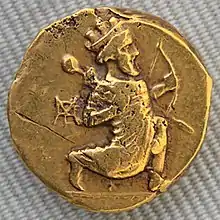
Artaxerxes again attempted to mediate in conflicts between the Greek city-states at the time of the Theban hegemony, especially the Theban–Spartan War. He sent Philiscus of Abydos, a hyparch (vice-regent) and military commander of the Achaemenid satrap Ariobarzanes, to Delphi in order to help the Greek negotiate peace.[16][17][18] The objective of Philicus of Abydos was such to help broker a Common Peace between the Greek belligerents reunited at Delphi.[18] The negotiation collapsed when Thebes refused to return Messenia to the Spartans.[18]
Before returning to Abydos, Philicus used Achaemenid funds to finance an army for the Spartans, suggesting that he was acting in support of the Spartans from the beginning.[18] With the Achaemenid financing of a new army, Sparta was able to continue the war.[19] Among the mercenaries whom he had recruited, Philiscus gave 2,000 to the Spartans.[16] He also probably provided funds to the Athenians and promised them, on behalf of the King, to help them recover the Chersonese militarily.[16] Both Philiscus and Ariobarzanes were made citizens of Athens, a remarkable honor suggesting important services rendered to the city-state.[16]
During autumn of 367 BCE, first the Spartans, soon followed by the Athenians, the Arcadians, the Argives, the Eleans, the Thebans, and other Greek city-states, sent envoys to Susa in attempts to obtain the support of Achaemenid king Artaxerxes II in the Greek conflict.[18] The Achaemenid king proposed a new peace treaty, this time highly tilted in favour of Thebes, which required Messenia to remain independent and that the Athenian fleet to be dismantled. This Peace proposal was rejected by most Greek parties except Thebes.[20][19]
Sparta and Athens, dissatisfied with the Persian king's support of Thebes, decided to provide careful military support to the opponents of the Achaemenid king. Athens and Sparta provided support for the revolted satraps, in particular Ariobarzanes. Sparta sent a force to Ariobarzanes under an aging Agesilaus II, while Athens sent a force under Timotheus, which was however diverted when it became obvious that Ariobarzanes had entered frontal conflict with the Achaemenid king.[19][17] An Athenian mercenary force under Chabrias was also sent to the Egyptian Pharao Tachos, who was also fighting against the Achaemenid king.[19]
Building projects
_Upper_Relief_soldiers_with_labels.jpg.webp)
Much of Artaxerxes' wealth was spent on building projects. He restored the Palace of Darius I at Susa,[22] and also the fortifications; including a strong redoubt at the south-east corner of the enclosure and gave Ecbatana a new apadana and sculptures.
Tomb at Persepolis
The tomb of Artaxerxes II is located at Persepolis, and was built on the model of his predecessors at Naqsh-e Rustam. On the upper register of the tomb appear reliefs of the Emperor, supported by the soldiers of all ethnicities of the Empire. On the lintel over each figure appears a trilingual inscription describing each ethnicity.[21] These are known collectively as "Inscription A2Pa".
 Tomb of Artaxerxes II in Persepolis.
Tomb of Artaxerxes II in Persepolis._Upper_Relief.jpg.webp) Upper Relief of the tomb of Artaxerxes II.
Upper Relief of the tomb of Artaxerxes II._Upper_Relief_Indian_soldiers_with_labels.jpg.webp) Soldiers of many ethnicities on the upper relief
Soldiers of many ethnicities on the upper relief
Legacy
The Persian Empire under Artaxerxes II was viewed as a political power that had many unfortunate complications, such as the many wars with Greece. One aspect of his legacy which would have great influence upon his successors was his conflict with Cyrus the Younger. This conflict was remembered due to the power vacuum that followed, allowing the Satrap Revolt and the rebellion of Egypt. Artaxerxes II was also remembered for his works to restore monuments of his predecessors. His largest restoration was that of the Palace of Darius in Susa. He would also be remembered for his tomb in Persepolis.
The image of Artaxerxes from contemporary foreign sources depicts him in a similar light to his image among those in the Achaemenid Empire. The Greek portrayal highlights his long rule with many conflicts and shortcomings of Artaxerxes II in his ability to control his empire. Greek sources also focus on his problems in his court with his harem and eunuchs. Greek sources portray Artaxerxes II as sad in his reign.[23]
Identification
The Jewish high priest Johanan is mentioned in the Elephantine papyri[24][25] dated to 407 BC, i.e., during Darius II's reign, and is also mentioned in Ezra 10:6 after the reign of Darius (Ezra 6:1) and during the rule of Artaxerxes (Ezra 7:1), thereby supporting the chronological sequence.
Amongst others, it has been suggested that Artaxerxes II was the Ahasuerus mentioned in the Book of Esther. Plutarch in his Lives (AD 75) records alternative names Oarses and Arsicas for Artaxerxes II Mnemon given by Deinon (c. 360–340 BC[26]) and Ctesias (Artexerxes II's physician[27]) respectively.[28] These derive from the Persian name Khshayarsha as do "Ahasuerus" ("(Arta)Xerxes") and the hypocoristicon "Arshu" for Artaxerxes II found on a contemporary inscription (LBAT 162[29]). These sources thus arguably identify Ahasuerus as Artaxerxes II in light of the names used in the Hebrew and Greek sources and accords with the contextual information from Pseudo-Hecataeus and Berossus[30] as well as agreeing with Al-Tabari and Masudi's placement of events. The 13th century Syriac historian Bar-Hebraeus in his Chronography, also identifies Ahasuerus as Artaxerxes II citing the sixth century AD historian John of Ephesus.[31][32]
Issue
Artaxerxes II is reported to have had a number of wives. His main wife was Stateira, until she was poisoned by Artaxerxes' mother Parysatis in about 400 BC. Another chief wife was a Greek woman of Phocaea named Aspasia (not the same as the concubine of Pericles). Artaxerxes II is said to have more than 115 sons from 350 wives.[33]
- By Stateira
- Artaxerxes III
- Darius
- Ariaspes or Ariarathes
- Rhodogune, wife of satrap Orontes I
- Atossa, wife of Artaxerxes II & then Artaxerxes III
- By other wives
- Arsames
- Mithridates
- Phriapatius(?), probable ancestor of Arsacids
- Amestris, wife of Artaxerxes II
- Apama, wife of Pharnabazus
- Ocha, mother of an unnamed wife of Artaxerxes III
- The unnamed wife of Tissaphernes
- 112 other unnamed sons
References
- R. Schmitt. "ARTAXERXES". Encyclopædia Iranica. 15 December 1986. Retrieved 12 March 2012.
- electricpulp.com. "ARTAXERXES II – Encyclopaedia Iranica". www.iranicaonline.org. Retrieved 4 February 2018.
- "Cyrus the Younger - Livius". www.livius.org. Retrieved 2019-05-08.
- "The Achaemenid Empire". Iranologie.com. 2014-04-25. Retrieved 2019-04-30.
- Snodgrass, Mary Ellen (2015). Coins and Currency: An Historical Encyclopedia. McFarland. p. 125. ISBN 9781476611204.
- "Persian coins were stamped with the figure of an archer, and Agesilaus said, as he was breaking camp, that the King was driving him out of Asia with ten thousand "archers"; for so much money had been sent to Athens and Thebes and distributed among the popular leaders there, and as a consequence those people made war upon the Spartans" Plutarch 15-1-6 in Delphi Complete Works of Plutarch (Illustrated). Delphi Classics. 2013. pp. 1031, Plutarch 15-1-6. ISBN 9781909496620.
- Schwartzwald, Jack L. (2014). The Ancient Near East, Greece and Rome: A Brief History. McFarland. p. 73. ISBN 9781476613079.
- Ruzicka, Stephen (2012). Trouble in the West: Egypt and the Persian Empire, 525-332 BC. New York, NY: Oxford University Press. pp. 55–62. ISBN 978-0-19-976662-8.
- Gershevitch, I.; Fisher, William Bayne; Boyle, John Andrew; Yarshater, Ehsan; Frye, Richard Nelson (1985). The Cambridge History of Iran. Cambridge University Press. p. 372. ISBN 9780521200912.
- Grimal (1992), pp. 375–376
- Ruzicka, Stephen (2012). Trouble in the West: Egypt and the Persian Empire, 525-332 BC. Oxford University Press. pp. 99–105. ISBN 9780199908776.
- Gershevitch, I.; Fisher, William Bayne; Boyle, John Andrew; Yarshater, Ehsan; Frye, Richard Nelson (1985). The Cambridge History of Iran. Cambridge University Press. p. 373. ISBN 9780521200912.
- Lloyd (1994), p. 348
- Gershevitch, I.; Fisher, William Bayne; Boyle, John Andrew; Yarshater, Ehsan; Frye, Richard Nelson (1985). The Cambridge History of Iran. Cambridge University Press. p. 374. ISBN 9780521200912.
- Grimal (1992), p. 377
- Heskel, Julia (1997). The North Aegean Wars, 371-360 B.C. Franz Steiner Verlag. p. 113. ISBN 9783515069175.
- Heskel, Julia (1997). The North Aegean Wars, 371-360 B.C. Franz Steiner Verlag. p. 96. ISBN 9783515069175.
- Fine, John Van Antwerp (1983). The Ancient Greeks: A Critical History. Harvard University Press. p. 584. ISBN 9780674033146.
- Souza, Philip de; France, John (2008). War and Peace in Ancient and Medieval History. Cambridge University Press. p. 41. ISBN 9781139469487.
- Fine, John Van Antwerp (1983). The Ancient Greeks: A Critical History. Harvard University Press. p. 585. ISBN 9780674033146.
- Briant, Pierre (2015). Darius in the Shadow of Alexander. Harvard University Press. p. 25. ISBN 9780674493094.
- "Achaemenid Royal Inscriptions: A2Sa". www.livius.org. Retrieved 2015-06-21.
- Briant, Pierre (2015). Darius in the Shadow of Alexander. Harvard University Press. ISBN 9780674493094.
- Pritchard, James B. ed., Ancient Near Eastern Texts Relating to the Old Testament, Princeton University Press, third edition with supplement 1969, ISBN 9780691035031, p. 492
- Bezalel Porten (Author), J. J. Farber (Author), C. J. F. Martin (Author), G. Vittmann (Author), The Elephantine Papyri in English (Documenta Et Monumenta Orientis Antiqui, book 22), Koninklijke Brill NV, The Netherlands, 1996, ISBN 9781589836280, p 125-153.
- Wolfgang Felix, Encyclopaedia Iranica, entry Dinon, 1996–2008
- Jona Lendering, Ctesias of Cnidus, Livius, Articles on Ancient History, 1996–2008
- John Dryden, Arthur Hugh Clough, Plutarch's Lives, Little, Brown and Company, 1885
- M. A. Dandamaev, W. J. Vogelsang, A Political History of the Achaemenid Empire, BRILL, 1989
- Jacob Hoschander, The Book of Esther in the Light of History, Oxford University Press, 1923
- E. A. W. Budge, The Chronography of Bar Hebraeus, Gorgias Press LLC, reprinted 2003
- Jan Jacob van Ginkel, John of Ephesus. A Monophysite Historian in Sixth-century Byzantium, Groningen, 1995
- "The Achaemenid Empire". Retrieved 2015-06-21. Archived 2008-06-19 at the Wayback Machine
External links
| Wikimedia Commons has media related to Artaxerxes II. |
- Artaxerxes by Plutarch
- H. Hunger & R.J. van der Spek, "An astronomical diary concerning Artaxerxes II (year 42 = 363-2 BC). Military operations in Babylonia" in: Arta 2006.002
- Inscriptions of Artaxerxes II in transcribed Persian and in English translation.
Artaxerxes II Born: c. 436 BC Died: 358 BC | ||
| Preceded by Darius II |
Great King (Shah) of Persia 404 BC – 358 BC |
Succeeded by Artaxerxes III |
